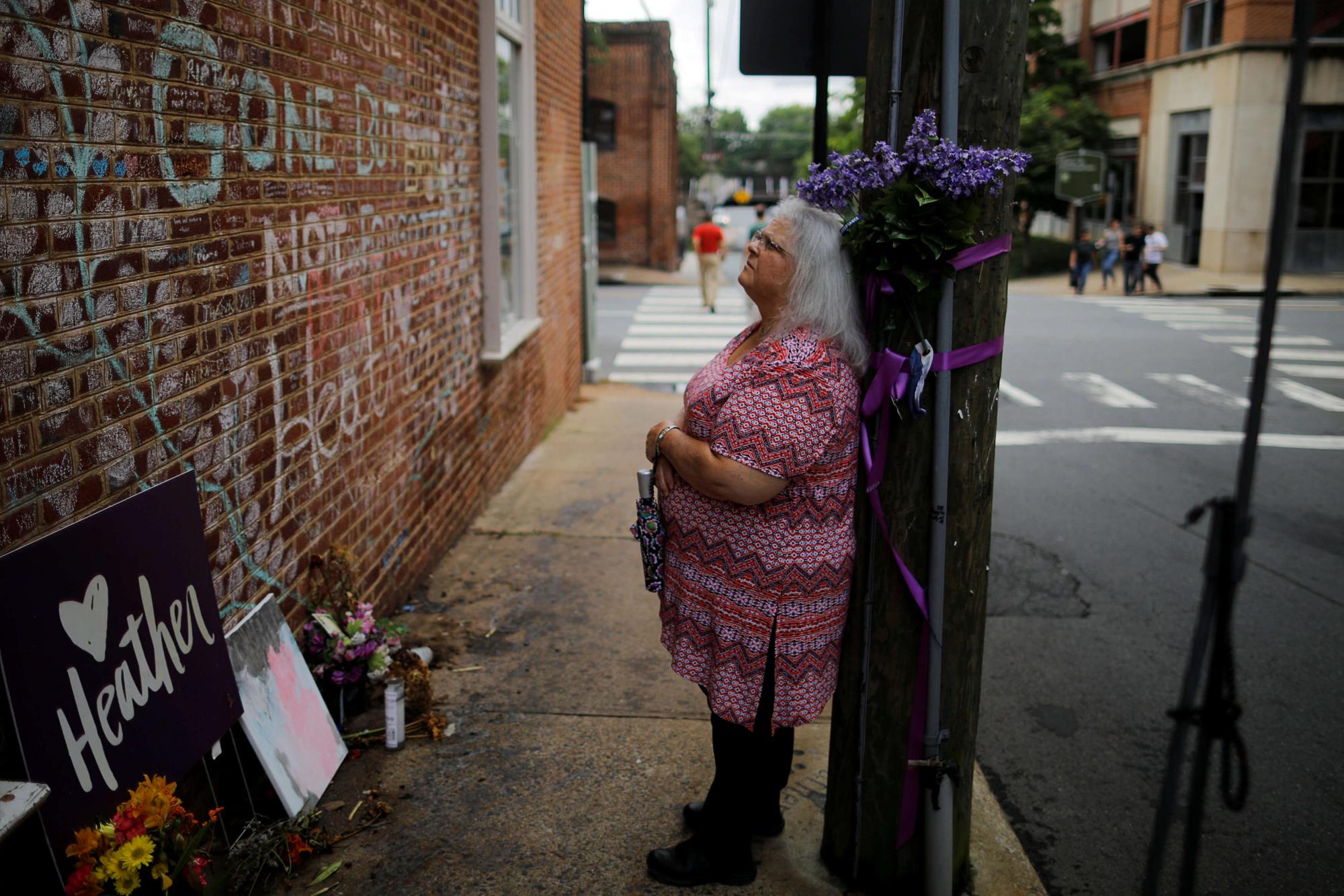
Susan Bro, mother of Heather Heyer, who was killed during the August 2017 white nationalist rally in Charlottesville, stands at the memorial at the site where her daughter was killed in Charlottesville, Va., July 31, 2018. REUTERS/Brian Snyder
The Lasting Trauma of White Nationalist Violence in Charlottesville
by Jordan Green
On the weekend of Aug. 11-12, 2017, the most violent factions of the neo-Nazi movement converged with a new generation of internet trolls, spilling onto the streets of Charlottesville, Va., in the largest gathering of white supremacists the United States had seen in two decades.
On the night before the main event, hundreds of young, white men carried torches to the Rotunda at the University of Virginia in an unannounced rally reminiscent of the Ku Klux Klan and the Third Reich. They attacked student protesters while chanting, “Jews will not replace us,” and “white lives matter.” The next day they clashed in the streets with anti-fascist counter-protesters, and 20-year-old James A. Fields Jr. from Ohio drove his car into a crowd of anti-racist marchers, killing Heather Heyer and injuring at least 19 others.
Over the past year, activists and faith groups have worked to find a way forward, while reflecting on the long history that led to that tragic day.
'Failure to protect public safety'
A civil suit filed by Charlottesville residents injured paints a vivid picture of how as series of individual events led to an eruption of violence on Aug. 12.
According to the complaint, at one point a rallygoer spotted Hannah Pearce, a plaintiff in the suit and member of the Congregation Beth Israel, who wore a Star of David as she protested the neo-Nazis at Emancipation Park. He allegedly shouted, “Oh good, they are marking themselves for us, so it is easy to find them.” A white supremacist later threw an open bottle of foul liquid at Pearce, striking her in the leg.
The Rev. Seth Wispelwey, an ordained minister with the United Church of Christ and grassroots organizer, linked arms with fellow clergy members after an interfaith sunrise prayer service and knelt in front of a phalanx of white supremacists approaching Emancipation Park. The white supremacists charged through the clergy, knocking Wispelwey into a bush. One of them stared him directly in the eyes while repeatedly shouting, “F--k you, f--got.”
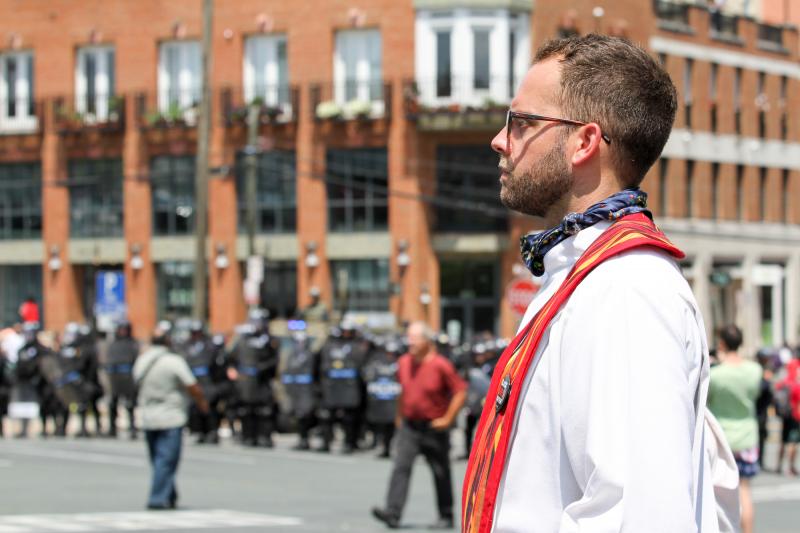
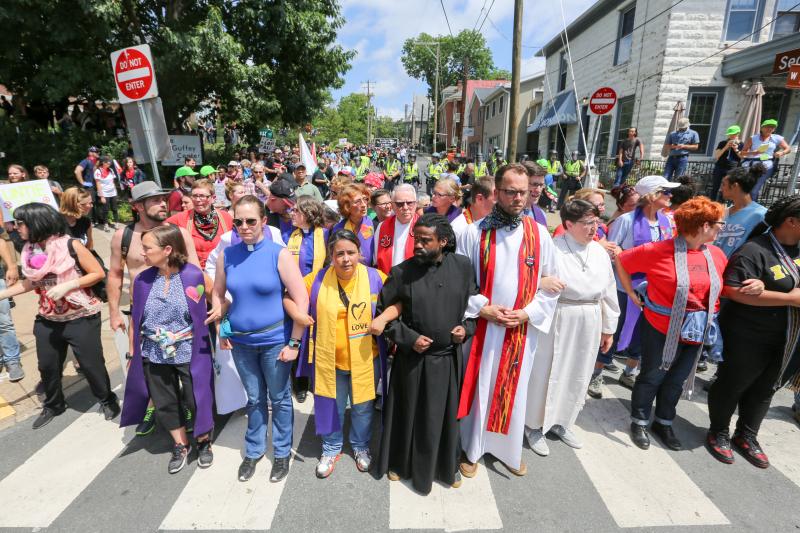
FILE PHOTOS: Rev. Seth Wispelway, left, looks on at protesters during the Aug. 12, 2017 counterprotest. Right, Wispelway joins other faith leaders processing through downtown Charlottesville. Photos by Heather Wilson / Dust & Light Photography
Around 10 a.m. on Saturday, as street skirmishes intensified between Unite the Right demonstrators and antifascists, Tanesha Hudson pleaded with Charlottesville police, who remained across the barricades from the combatants, to do something. As documented in a report prepared for the city by the Hunton & Williams law firm, a police sergeant told Hudson: “When things happen, we’ll respond.”
“When they happen?” she asked in disbelief. “You’re supposed to prevent it from happening.”
Twenty minutes later, when Hudson again returned to the barricades to request police assistance, a lieutenant explained to her that the police hadn’t anticipated that counter-protesters would avoid the area designated for them. When Hudson suggested the police could spare three to five officers to go to the southwest corner of the park where the violence was most intense, another sergeant asked, “What are three or five cops going to do down there with that crowd?”
Hudson retorted, “What the hell are 40 of y’all gonna do right here?”
Released 10 weeks after Unite the Right, the Hunton & Williams report described Charlottesville as “a fractured city.” The report was unsparing in its assessment of the city’s handling of the event:
“The passive law enforcement response to violence on August 12 represents a tremendous tactical failure that has real and lasting consequences. People were injured in violent confrontations that could have been but were not prevented by police.”
Ongoing trauma
For anti-racist activists, clergy, and others on the frontlines, the sense of siege after last summer’s violence has never really lifted.
“We’re famous across the globe; a lot of people around the world know what happened,” Grace Aheron, an organizer with Standing Up for Racial Justice Charlottesville, told Sojourners. “It faded in the public eye, but it felt the same for us. It felt like August never faded.”
After the violence itself, a primary harm mentioned time and again by local activists is the feeling of being gas-lit by the city of Charlottesville and other residents.
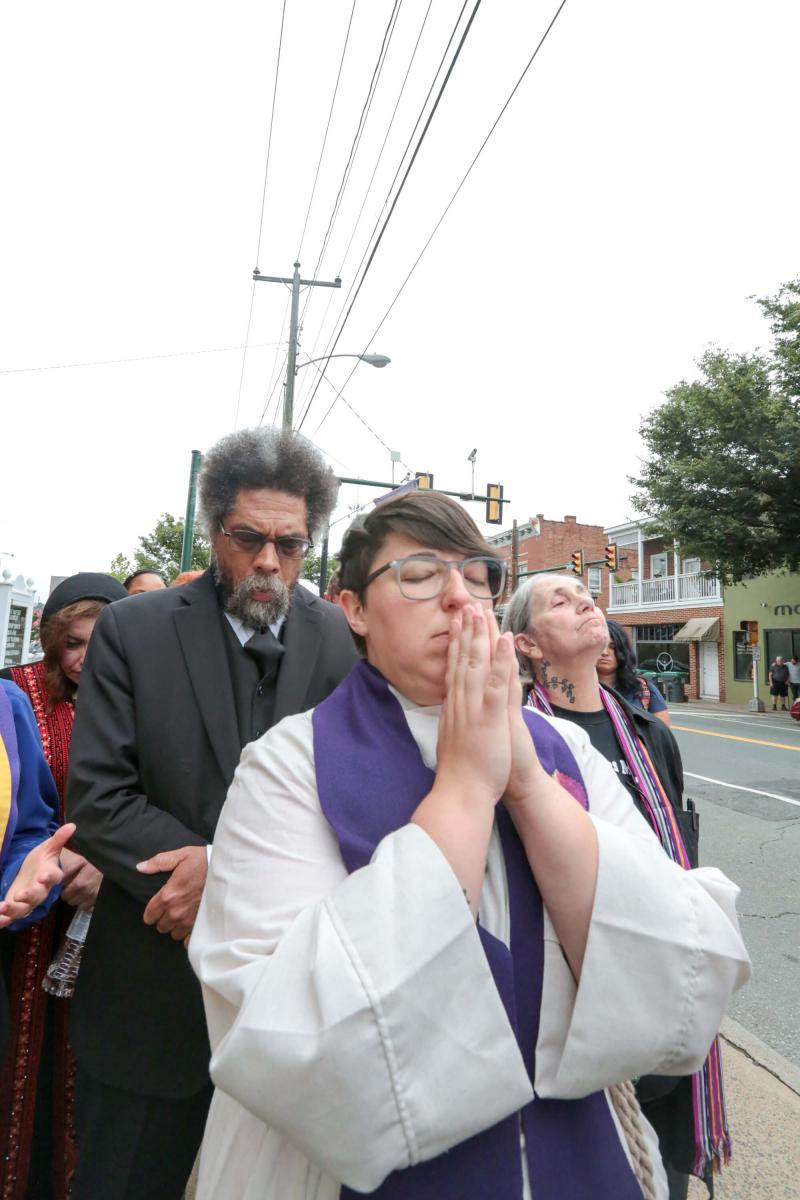
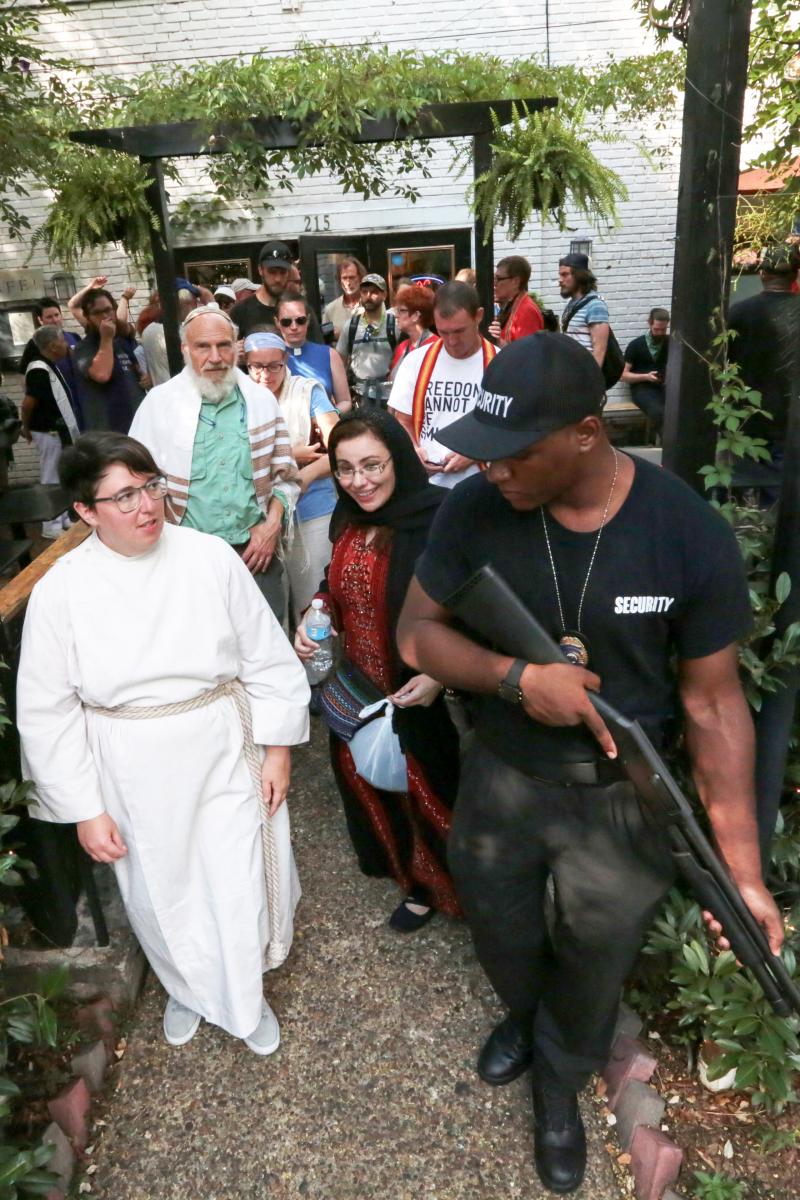
FILE PHOTOS: Left, Rev. Brittany Caine-Conley proceeds through downtown Charlottesville, followed by Dr. Cornel West Aug. 12, 2017. Right, Caine-Conley joins other faith leaders. Photos by Heather Wilson / Dust & Light Photography
“A lot of folks are dealing with expensive psychological trauma,” said the Rev. Brittany Caine-Conley, who cofounded Congregate Charlottesville with Wispelwey. “There’s trauma in the fact that people warned the city about violence, and the city perpetuated the myth that everything’s OK, stay home; there’s a lot of trauma wrapped up in that.
“The trauma of white supremacy is wrapped up in the legal system,” Caine-Conley continued. “There’s the trauma of knowing that your city is under siege. Many of us have become very vigilant. Many activists have been targeted online through doxing. Continuing to carry conflict with you at all times is traumatic. Many of us are trying to figure out how to exist in the new normal.”
Those who took the brunt of the violence in August 2017 have carried different levels of residual trauma.
“I feel very resilient,” Tom Gutherz, the senior rabbi at Congregation Beth Israel, said. “It certainly was shocking to see that sort of murderous antisemitism expressed so publicly in our community in Charlottesville. We felt supported by a larger community of people that are fighting against white supremacy. We are curious about it. We are wondering how deeply those feelings of [antisemitism] permeate society.”
The 'cradle of white supremacy'
Tanesha Hudson, a fifth-generation African-American resident of Charlottesville, said the violence in August 2017 served to reinforce a longstanding pattern of racist policies that has continued with the city’s failure to provide adequate police protection and lack of commitment to affordable housing. In a city that was majority black in 1865 when it was liberated by the Union army, blacks now make up only 18.7 percent of the population. Hudson described the experience of living in Charlottesville as a black person as something akin to being a student of color on a predominantly white Ivy League campus, where they’re both excluded and chastised for trying to maintain their own community.
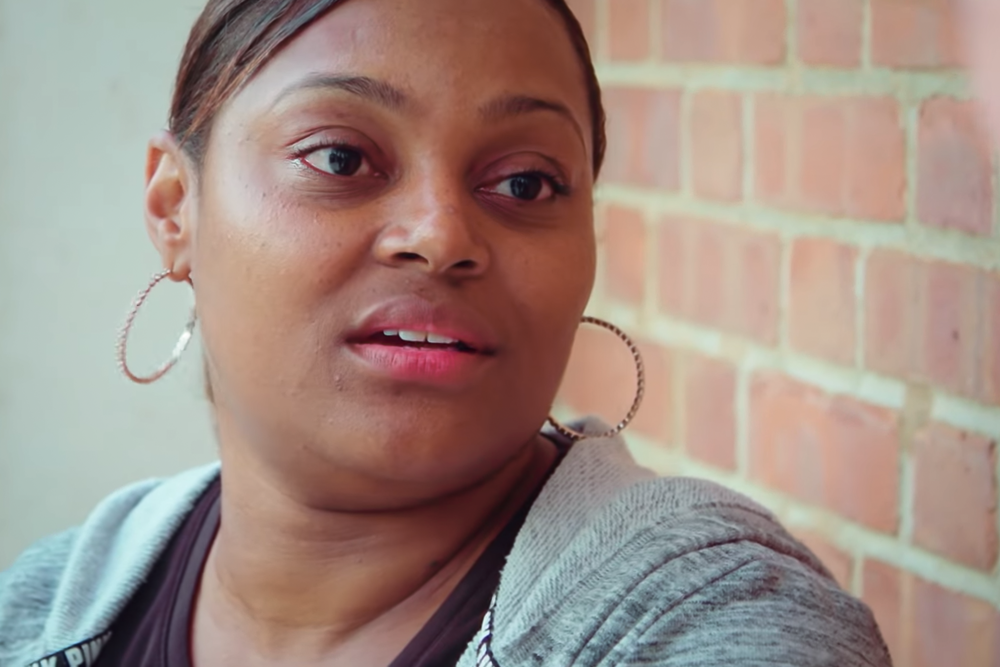
Tanesha Hudson speaks to the Guardian in a short documentary on the Charlottesville anniversary.
“This is a segregated town,” Hudson said. “… Black people go downtown, but we don’t feel welcomed at 90 percent of the restaurants on the Mall. We have to feel a certain way for being in our spaces, but white people are never told they should feel bad about being in all-white spaces. We have to be apologetic for loving and wanting to support our own.”
The Confederate memorials, which provided a rallying point for Unite the Right organizers Jason Kessler and Richard Spencer, remain a tangible reminder of ongoing violence against people of color.
A February 1919 article in The Daily Progress, described how Paul Goodloe McIntire, a white philanthropist, resolved to build “attractive parks and magnificent monuments” to honor Confederate military leaders. The civic mobilization in Charlottesville and other Southern communities to build Confederate monuments after World War I coincided with a racial pogrom across the country in the summer of 1919. As described in the autobiography of noted civil rights leader James Weldon Johnson:
“During the summer, bloody race riots occurred in Chicago, in Omaha, in Longview, Texas, in Phillips County, Arkansas, in Washington and other communities. The riot in the national capital lasted three days, during which Negroes were hunted through the streets, dragged from street corners, beaten, and even killed.”
The donation the Robert E. Lee sculpture to the city by McIntire also coincided with the resurgence of the Ku Klux Klan in Charlottesville and across the country. In June 1921, The Daily Progress reported:
“Hundreds of Charlottesville business and professional men met around the tomb of Jefferson at the midnight hour one night last week and sealed the pledge of chivalry and patriotism with the deepest crimson of red American blood. It is said that the reorganization of the Klan is proceeding rapidly throughout the state, the South and the nation.”
The next month the local newspaper republished a Klan flier declaring “all undesirables must leave town,” while inviting “native-born, white Americans who hold no allegiance to any government, sect, ruler, person or people that is foreign to the United States” to join the organization.
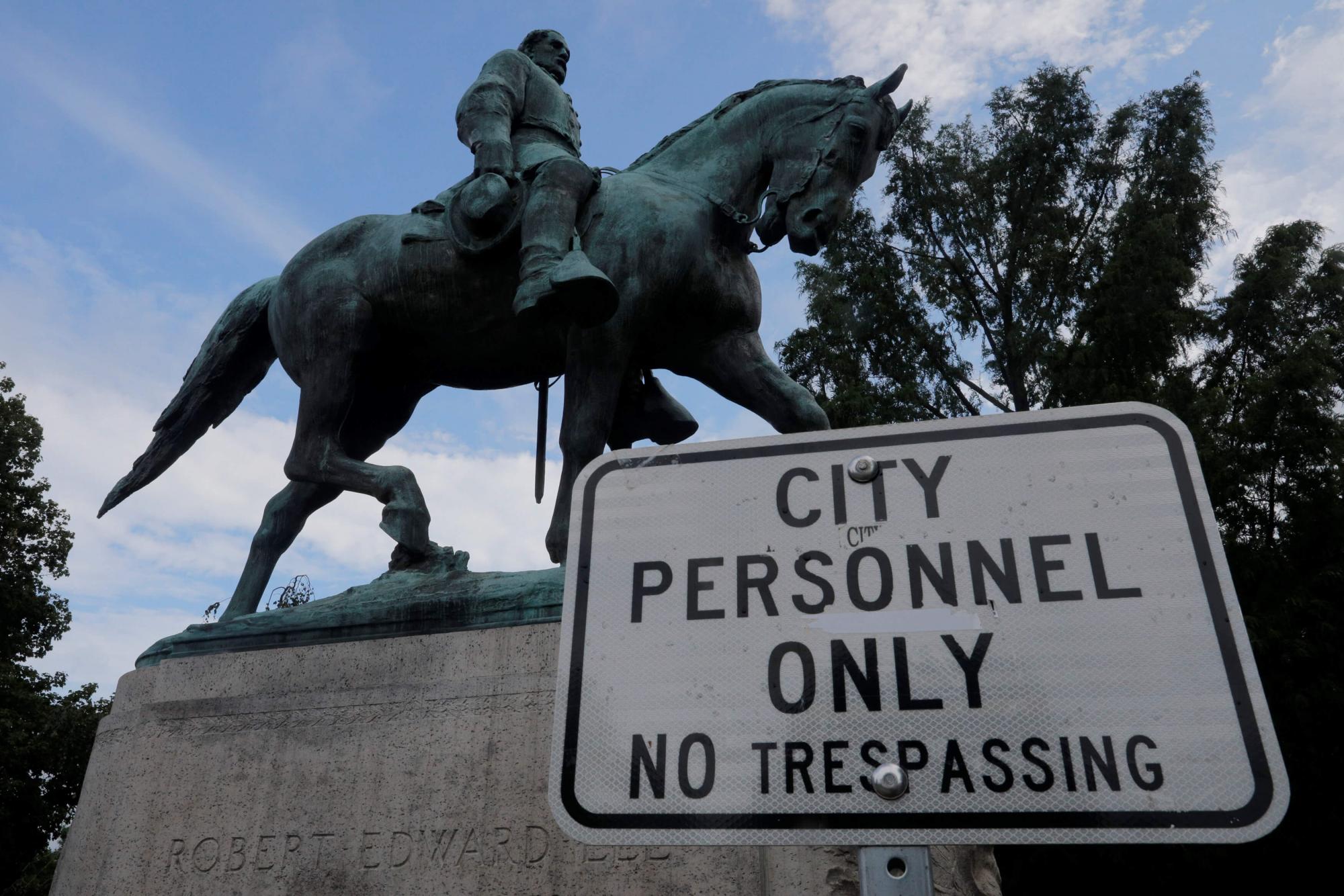
A statue of Civil War Confederate General Robert E. Lee stands in a park, ahead the one-year anniversary of the fatal white-nationalist rally, in Charlottesville, Va., Aug. 1, 2018. REUTERS/Brian Snyder
Frank Dukes, who served on the city’s Blue Ribbon Commission on Race, Memorials and Public Spaces, told Sojourners that Charlottesville is in some ways “kind of the cradle of white supremacy,” noting the city’s association with not only Thomas Jefferson but also James Madison, two founders who were party to the infamous Three-Fifths Compromise, which diminished the humanity of black people and gave the slave-holding Southern states an electoral advantage in Congress up to 1861.
Is reconciliation possible?
Antiracist activists in Charlottesville have committed to addressing the city’s history of white supremacy, not just the events that led up to Unite the Right. In early July, about 100 local residents joined the Charlottesville Pilgrimage. They carried soil gathered from the location where a black man named John Henry James was lynched in 1898 to the Equal Justice Initiative’s National Memorial for Peace and Justice in Montgomery, Ala. Along the way, they stopped in Greensboro, N.C., where a coalition of neo-Nazis and Klansmen fatally shot five antiracist activists in a black housing project in 1979. The Rev. Nelson Johnson and his wife, Joyce, survivors of the massacre, hosted the Charlottesville delegation in the sanctuary of Faith Community Church, where Johnson recently retired as senior pastor.
As the onetime leader of the now-defunct Communist Workers Party and pastor committed to social justice, Nelson Johnson has cultivated a kind of dialectic of struggle and reconciliation rooted in liberation theology. The Johnsons and other survivors helped establish the only truth and reconciliation commission on U.S. soil, which held hearings and released a report in 2006.
Nelson Johnson told the Charlottesville delegation, which included Mayor Nikuyah Walker, how as a seminary student he went to visit a Klan leader eight years after the massacre to lobby against the white supremacist group’s return to the Greensboro. He emphasized the idea of trying to find the humanity in one’s enemy. The encounter might not change that one person’s heart, but it would be transformative, Johnson argued.
“So you don’t have to pin this on one person who may be in this context of the iteration of his incarnation [and] can’t change,” Johnson said. “But we don’t know how the universe works and whether you get another chance. But what we know is we do what we can do without allowing our own belief to be robbed by a robber whose intent is to get you to fight him on his own level. And that point you become who he is ….”
As Johnson’s sermon built to a mighty crescendo, the Charlottesville residents erupted in rapturous applause.
“I know what we got in us,” Johnson continued. “I know we’ll fight. Somebody asked me: ‘If somebody attacked your wife and you were there, what would you do?’ I said, ‘I’d do everything I can to protect her, up to and including if I had to ….’” He left the final thought unspoken, and then continued, “But it’s not my desire to do that. It’s not my desire. Get that in your heart, and everything else kind of gets worked out.”
Tanesha Hudson was one of the Charlottesville residents in the audience. She thanked Johnson.
“I like you because not once have you told people to not be angry,” Hudson said. “Because I can still hear the rage inside you. And I feel that rage sometimes is a driving force for people that continue the movement to keep it going.”
The question remained whether the truth and reconciliation model could work for Charlottesville, and, indeed, for the whole country.
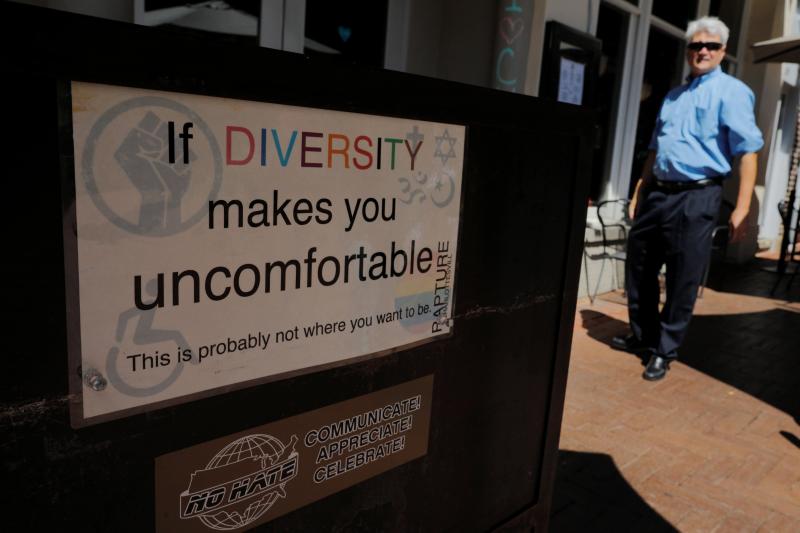
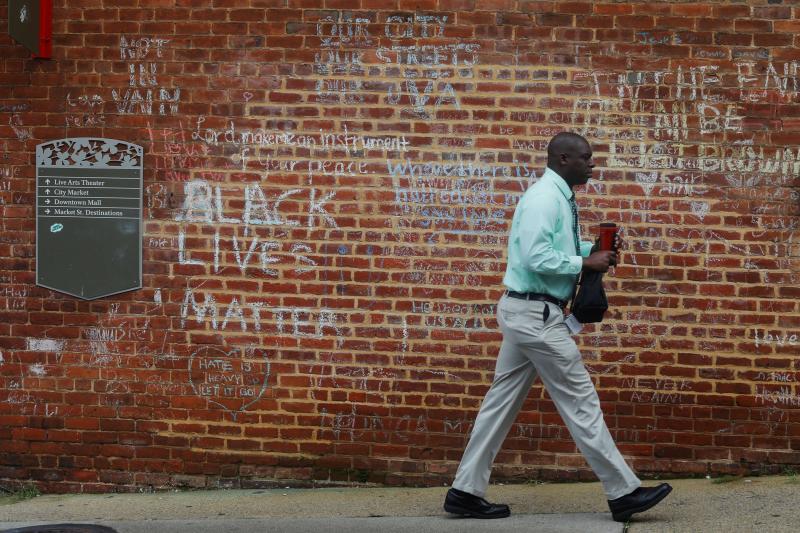
Left, a man walks past tributes written at the site where Heather Heyer was killed during the 2017 white-nationalist rally in Charlottesville, Va., Aug. 1, 2018. Right, a sign supporting diversity stands outside the Rapture Restaurant in Charlottesville, Va.. Photos: REUTERS/Brian Snyder
Confronting white supremacy
Greensboro’s trauma is similar to Charlottesville’s in some ways: In both cities, the police failed to protect citizens from white supremacist violence, and the courts were ill equipped to respond to a coordinated paramilitary-style assault. In other ways, the two events are much different. In Greensboro, the antifascist movement was shattered. The Communist Workers Party dissolved, and the survivors went into hiding or left town. In contrast, after the Unite the Right rally in Charlottesville, the alt-right coalition fractured in the face of resistance in the streets, legal challenges, and the widespread public backlash to the violence, although dehumanizing rhetoric and policies that harm people of color and others remain very much in ascendancy across the country.
“Charlottesville is a very resilient community,” the Rev. Brittany Caine-Conley said. “Because of the resistance we were able to organize last year, we prevented [this year’s] Unite the Right from taking place. We galvanized other communities to show up and shut down white supremacist rallies. Confrontation of violent white supremacist works. It’s disabling their movement.”
Few, if any, antiracist activists in Charlottesville see a point in following Rev. Johnson’s example by opening dialogue with white supremacist adversaries. Local faith leaders from the Rev. Wispelwey to Rabbi Gutherz told Sojourners they don’t feel the need.
SURJ organizer Grace Aheron put it this way: “I think because this historical moment in our country is so intense and the situation is so serious we don’t have time to be using tactics that are based on hoping someone will change their mind. We need to act against what’s happening right now, which means directly confronting these terrible policies, confronting systemic oppression, and creating alternatives to enact liberation."
“[Jesus] didn’t spend time trying to change the mind of Caesar. He was demonstrating the kind of world that could exist." —Grace Aheron
On the one-year anniversary of the first Unite the Right rally, Charlottesville remains awkwardly poised between reflection and vigilance. Local faith leaders and activists are encouraging an antifascist response to the official Unite the Right 2 rally scheduled to take place in Washington, D.C., on Aug. 12, but they’re also on guard against the possibility of unannounced white supremacist rallies in Charlottesville over the weekend.
Congregate Charlottesville is hosting a “Service for Repair” at First Presbyterian Church at 3 p.m. on Aug. 11. Wispelwey said Congregate will be providing safe spaces for rejuvenation and reflection at “hot spots” around the city, including the Rotunda on the campus of the University of Virginia.
“There’s always the possibility of violence,” he said. “We’ll have people who are willing to engage as necessary.”
Congregate Charlottesville is issuing a national call to action in Charlottesville, Washington, D.C., and around the country.
“We appreciate prayers and resources,” Caine-Conley said. “But as a faith leader, I call on people of faith to enact your faith by confronting white supremacy in your own communities.”
Got something to say about what you're reading? We value your feedback!


